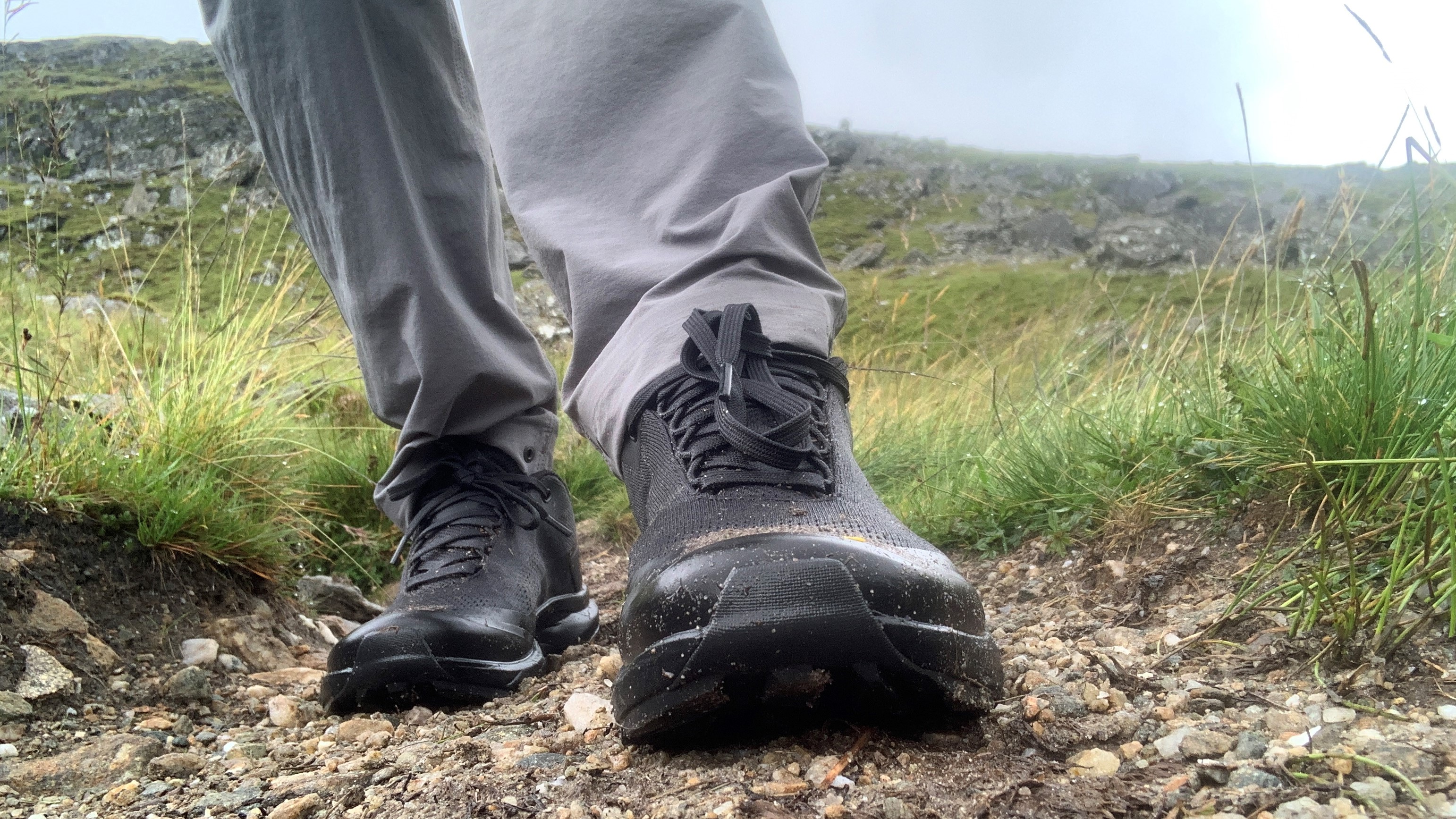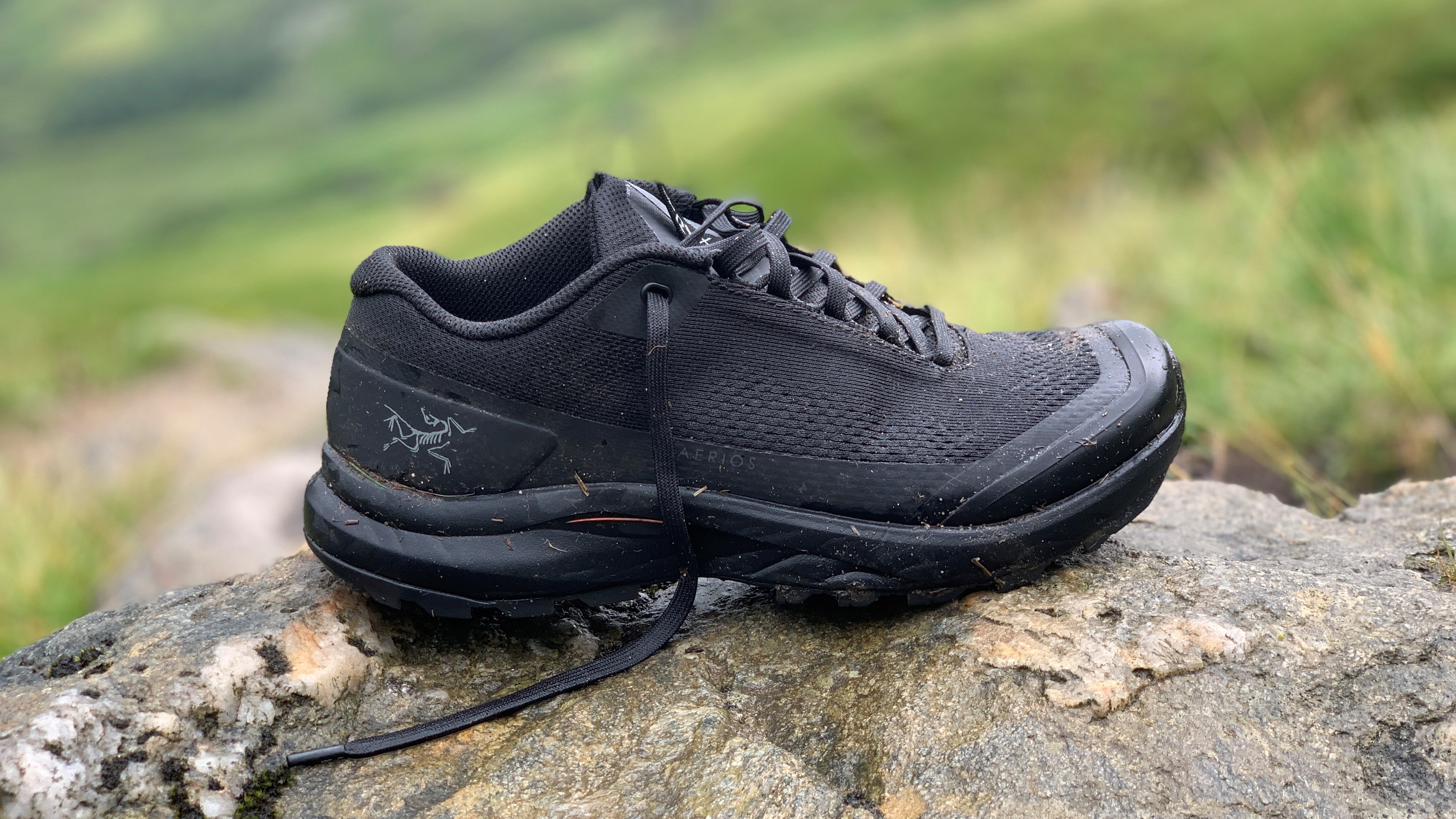Advnture Verdict
Blending breathable trail running technology with the reinforcement you want for long days on the trail, this makes an extremely comfortable shoe for summer hikes
Pros
- +
Out-of-the-box comfort
- +
Good grip in slick conditions
- +
Breathable
- +
Lightweight
- +
Made using recycled materials
- +
Decent toe protection
Cons
- -
No ankle support or protection
- -
No suited to winter or wet conditions
- -
Laces come untied easily
- -
Not many colors to choose from
You can trust Advnture
Arc’teryx Aerios Aura shoe: first impressions
The Aerios Auro is a hiking shoe built for fair weather, but that doesn’t mean it won’t hold up against scrambles and slick terrain. The design team at Arc’teryx have used trail running technology to reinforce these shoes with supreme breathability thanks to mesh panels in areas where your feet tend to overheat. Stiff Vibram soles provided brilliant traction even when we tested them out in really steep, slick conditions and raised perimeter sidewalls increase stability and add protection on rougher trails.
• List price: $150 / £140
• Gender specification: Men’s and women’s sizing available
• Sizes: Men’s 7 - 13 (US), 6.5 - 12/5 UK; Women’s 5 - 10 US, 3 - 8.5 UK
• Materials: Recycled polyester engineered mesh, TPU high abrasion protection films
• Weight (per shoe): 270g (women’s UK 4)
• Colors: Black, Solasta/bliss
• Best use: Hiking
Perhaps the best selling point of these shoes, however, is that you can pull them out of the box and get straight on the trail without any breaking in required. For hot and mostly dry days, they provide all the breathability you need, but obviously they’re not built for cold or super wet conditions. Basically, if you’re looking for a shoe that has more of a light trainer feel but offers you protection from the terrain underfoot, you’ll want to try a pair of these on for size.
Arc’teryx Aerios Aura shoe: in the field

I first tried these shoes out in Chamonix when I was attending the Arc’teryx Alpine Academy and I was hiking in warm but humid conditions on a steep but well-maintained trail. Since I’ve had them back in Scotland, I’ve given them a run for their money on some very steep and wet trails including bushwhacking up a Munro in the rain – it’s not exactly what they’re intended for, since they’re not waterproof, but it’s given me a good idea of what they can handle.
Here’s how they performed:
Sizing and fit
I wear a UK size 3.5 but always size up to a 4 for hiking and running shoes. These shoes in a 4 therefore seem to fit true to size, leaving me ample room in the toe box. In terms of fit, my feet are neither wide nor narrow and I think the same is true for these shoes. Just eyeballing them, they may not be wide enough for wide feet but they fit me great.
Comfort and breathability
The first thing I noticed about these shoes is that they are super comfortable, right out of the box. They were so comfortable that I wore them on a five mile hike from Chamonix up Montenvers and there wasn’t a hot spot in sight.
Part of the reason they’re so comfortable is because they’re so lightweight, but the breathability is also extremely effective, which I’ve noticed both on hot hikes as well as when I misguidedly wore them in rainy conditions – my feet got drenched, but also dried quickly.
Grip and protection
Because these have such a running shoe look and feel, it would be quite easy to think they won’t offer much protection, but in reality, the soles are stiff enough to protect my feet from the rocky alpine trails and the lugs are deep enough that even when I was hauling myself off-trail up an extremely steep, grassy and slick mountain, including several stream crossings, I only slipped one. I’d trust these on both wet and dry trails for traction.
As for protection, the raised perimeter sidewalls mean my feet are protected on all sides from roots and rocks, but obviously these aren’t hiking boots so there’s nothing to protect me from rolling my ankle or knocking my ankle against a rock for scrambling.
They don't offer any protection whatsoever from rain and wet grass in terms of keeping my feet dry, but I have waterproof shoes for that.
Julia Clarke is a staff writer for Advnture.com and the author of the book Restorative Yoga for Beginners. She loves to explore mountains on foot, bike, skis and belay and then recover on the the yoga mat. Julia graduated with a degree in journalism in 2004 and spent eight years working as a radio presenter in Kansas City, Vermont, Boston and New York City before discovering the joys of the Rocky Mountains. She then detoured west to Colorado and enjoyed 11 years teaching yoga in Vail before returning to her hometown of Glasgow, Scotland in 2020 to focus on family and writing.


